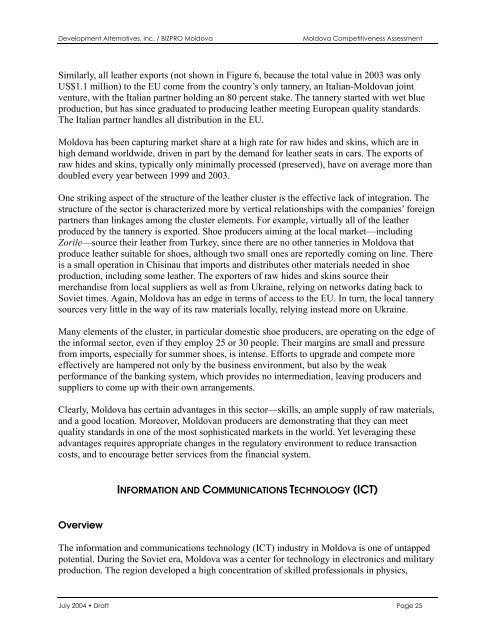Assessing Competitiveness In Moldova's Economy - Economic Growth
Assessing Competitiveness In Moldova's Economy - Economic Growth
Assessing Competitiveness In Moldova's Economy - Economic Growth
You also want an ePaper? Increase the reach of your titles
YUMPU automatically turns print PDFs into web optimized ePapers that Google loves.
Development Alternatives, <strong>In</strong>c. / BIZPRO Moldova Moldova <strong>Competitiveness</strong> Assessment<br />
Similarly, all leather exports (not shown in Figure 6, because the total value in 2003 was only<br />
US$1.1 million) to the EU come from the country’s only tannery, an Italian-Moldovan joint<br />
venture, with the Italian partner holding an 80 percent stake. The tannery started with wet blue<br />
production, but has since graduated to producing leather meeting European quality standards.<br />
The Italian partner handles all distribution in the EU.<br />
Moldova has been capturing market share at a high rate for raw hides and skins, which are in<br />
high demand worldwide, driven in part by the demand for leather seats in cars. The exports of<br />
raw hides and skins, typically only minimally processed (preserved), have on average more than<br />
doubled every year between 1999 and 2003.<br />
One striking aspect of the structure of the leather cluster is the effective lack of integration. The<br />
structure of the sector is characterized more by vertical relationships with the companies’ foreign<br />
partners than linkages among the cluster elements. For example, virtually all of the leather<br />
produced by the tannery is exported. Shoe producers aiming at the local market—including<br />
Zorile—source their leather from Turkey, since there are no other tanneries in Moldova that<br />
produce leather suitable for shoes, although two small ones are reportedly coming on line. There<br />
is a small operation in Chisinau that imports and distributes other materials needed in shoe<br />
production, including some leather. The exporters of raw hides and skins source their<br />
merchandise from local suppliers as well as from Ukraine, relying on networks dating back to<br />
Soviet times. Again, Moldova has an edge in terms of access to the EU. <strong>In</strong> turn, the local tannery<br />
sources very little in the way of its raw materials locally, relying instead more on Ukraine.<br />
Many elements of the cluster, in particular domestic shoe producers, are operating on the edge of<br />
the informal sector, even if they employ 25 or 30 people. Their margins are small and pressure<br />
from imports, especially for summer shoes, is intense. Efforts to upgrade and compete more<br />
effectively are hampered not only by the business environment, but also by the weak<br />
performance of the banking system, which provides no intermediation, leaving producers and<br />
suppliers to come up with their own arrangements.<br />
Clearly, Moldova has certain advantages in this sector—skills, an ample supply of raw materials,<br />
and a good location. Moreover, Moldovan producers are demonstrating that they can meet<br />
quality standards in one of the most sophisticated markets in the world. Yet leveraging these<br />
advantages requires appropriate changes in the regulatory environment to reduce transaction<br />
costs, and to encourage better services from the financial system.<br />
Overview<br />
INFORMATION AND COMMUNICATIONS TECHNOLOGY (ICT)<br />
The information and communications technology (ICT) industry in Moldova is one of untapped<br />
potential. During the Soviet era, Moldova was a center for technology in electronics and military<br />
production. The region developed a high concentration of skilled professionals in physics,<br />
July 2004 • Draft Page 25
















